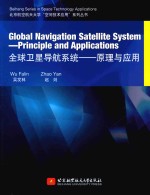图书介绍
全球卫星导航系统 原理与应用PDF|Epub|txt|kindle电子书版本网盘下载

- 吴发林,赵剡编著 著
- 出版社: 北京:北京航空航天大学出版社
- ISBN:9787512423473
- 出版时间:2017
- 标注页数:460页
- 文件大小:64MB
- 文件页数:472页
- 主题词:卫星导航-全球定位系统-高等学校-教材-英文
PDF下载
下载说明
全球卫星导航系统 原理与应用PDF格式电子书版下载
下载的文件为RAR压缩包。需要使用解压软件进行解压得到PDF格式图书。建议使用BT下载工具Free Download Manager进行下载,简称FDM(免费,没有广告,支持多平台)。本站资源全部打包为BT种子。所以需要使用专业的BT下载软件进行下载。如BitComet qBittorrent uTorrent等BT下载工具。迅雷目前由于本站不是热门资源。不推荐使用!后期资源热门了。安装了迅雷也可以迅雷进行下载!
(文件页数 要大于 标注页数,上中下等多册电子书除外)
注意:本站所有压缩包均有解压码: 点击下载压缩包解压工具
图书目录
Chapter 1 Introduction1
1.1 Overview1
1.2 U.S.Global Positioning System2
1.2.1 GPS Services4
1.2.2 GPS Modernization Program5
1.3 Russian GLONASS System7
1.4 Chinese BeiDou Satellite Navigation System9
1.4.1 BeiDou Program History10
1.4.2 BeiDou Services12
1.5 European Galileo Satellite System14
1.6 Augmentations16
1.7 Organization of the Book16
Review Questions19
Chapter 2 Fundamentals of Satellite Navigation21
2.1 Methods of Radionavigation21
2.1.1 Trilateration21
2.1.2 Hyperbolic Positioning23
2.1.3 Doppler Positioning24
2.2 Concept of Ranging Using TOA Measurements26
2.2.1 Two-Dimensional Position Determination26
2.2.2 Principle of Position Determination via Satellite-Generated Ranging Signals29
2.3 Reference Coordinate Systems31
2.3.1 Earth-Centered Inertial Coordinate System31
2.3.2 Earth-Centered Earth-Fixed Coordinate System32
2.3.3 World Geodetic System33
2.3.4 Height Coordinates and the Geoid36
2.3.5 GLONASS Coordinate Reference System39
2.3.6 BeiDou Geodetic Reference System40
2.3.7 Galileo Coordinate Reference System41
2.4 Time References and GNSS Time42
2.4.1 Time Scales:Astronomical and Atomic43
2.4.2 GNSS System Time48
2.5 Fundamentals of Satellite Orbits54
2.6 Position,Velocity and Time Estimation65
2.6.1 Determining Satellite-to-User Range66
2.6.2 Calculation of User Position69
2.6.3 User Velocity Estimation73
2.6.4 Time Estimation77
Review Questions77
Chapter 3 Functional Segments of GNSS79
3.1 Overview of the GNSS System79
3.1.1 Space Segment Overview80
3.1.2 Control Segment Overview81
3.1.3 User Segment Overview82
3.2 Space Segment82
3.2.1 GPS Space Segment82
3.2.2 GLONASS Space Segment88
3.2.3 BeiDou Space Segment93
3.2.4 Galileo Space Segment96
3.3 Control Segment99
3.3.1 GPS Control Segment99
3.3.2 GLONASS Control Segment118
3.3.3 BeiDou Control Segment118
3.3.4 Galileo Control Segment119
3.4 User Segment121
Review Questions122
Chapter 4 Stand-Alone GNSS Performance123
4.1 Introduction123
4.2 GNSS Error Sources124
4.2.1 Satellite Clock Error126
4.2.2 Ephemeris Error127
4.2.3 Relativistic Effects129
4.2.4 Atmospheric Effects131
4.2.5 Receiver Noise and Resolution146
4.2.6 Multipath and Shadowing Effects146
4.2.7 Hardware Bias Errors164
4.2.8 Pseudorange Error Budgets166
4.3 Accuracy168
4.3.1 Satellite Geometry and Dilution of Precision in GPS168
4.3.2 Accuracy Metries174
4.3.3 Weighted Least Squares(WIS)179
4.3.4 Additional State Variables180
4.3.5 Kalman Filtering181
4.4 Availability181
4.5 Integrity184
4.5.1 Discussion of Criticality184
4.5.2 Sources of Integrity Anomalies185
4.5.3 Integrity Enhancement Techniques186
4.6 Continuity200
Review Questions201
Chapter 5 GNSS Signals203
5.1 Introduction203
5.2 Modulations for Satellite Navigation203
5.2.1 Modulation Types203
5.2.2 Multiplexing Techniques206
5.2.3 Signal Models and Characteristics207
5.3 GPS Signals213
5.3.1 Legacy GPS Signals213
5.3.2 Modernized GPS Signals236
5.3.3 GPS Signal Summary242
5.4 GLONASS Signals243
5.4.1 GLONASS Frequencies243
5.4.2 Modulation245
5.4.3 Code Properties245
5.5 BeiDou Signals247
5.5.1 BeiDou Frequencies247
5.5.2 Open Service Signals248
5.5.3 Ranging Code249
5.6 Galileo Signals252
5.6.1 Frequencies and Signals252
5.6.2 Modulation Schemes255
5.6.3 SAR Signal Plan265
5.7 Navigation Message Format266
5.7.1 GPS Navigation Message266
5.7.2 GLONASS Navigation Message269
5.7.3 BeiDou Navigation Message271
5.7.4 Galileo Navigation Message275
Review Questions277
Chapter 6 GNSS Receivers279
6.1 Introduction279
6.2 GPS Receiver Architecture281
6.2.1 Radio Frequency(RF)Front End282
6.2.2 Frequency Down-Conversion and IF Amplification284
6.2.3 Analog-to-Digital Conversion and Automatic Gain Control286
6.2.4 Baseband Signal Processing287
6.3 GPS Signal Acquisition287
6.3.1 Tong Search Detector293
6.3.2 M of N Search Detector296
6.3.3 Direct Acquisition of GPS Military Signals298
6.4 GPS Signal Tracking301
6.4.1 Predetection Integration303
6.4.2 Baseband Signal Processing304
6.4.3 Digital Frequency Synthesis307
6.4.4 Carrier Aiding of Code Loop309
6.4.5 External Aiding310
6.5 Carrier Tracking Loops310
6.5.1 Phase Lock Loops311
6.5.2 Costas Loops314
6.5.3 Frequency Lock Loops317
6.6 Code Tracking Loops320
6.7 Formation of Pseudorange,Delta Pseudorange,and Integrated Doppler327
6.7.1 Pseudorange328
6.7.2 Delta Pseudorange346
6.7.3 Integrated Doppler348
6.8 Data Demodulation349
Review Questions350
Chapter 7 Differential GNSS352
7.1 Introduction352
7.2 Spatial and Time Correlation Characteristics of GPS Errors354
7.2.1 Satellite Clock Errors355
7.2.2 Ephemeris Errors355
7.2.3 Ionospheric Errors357
7.2.4 Tropospheric Errors360
7.2.5 Receiver Noise and Multipath364
7.3 Code-Based Techniques364
7.3.1 Local-Area DGNSS365
7.3.2 Regional-Area DGNSS368
7.3.3 Wide-Area DGNSS369
7.4 Carrier-Based Techniques370
7.4.1 Precise Baseline Determination in Real Time372
7.4.2 Static Application394
7.4.3 Airborne Application395
7.4.4 Attitude Determination399
7.5 RTCM Messages401
Review Questions402
Chapter 8 GNSS Applications403
8.1 Introduction403
8.2 Marine and Land Applications of GNSS403
8.2.1 Marine Navigation405
8.2.2 Land Navigation408
8.3 Aviation Applications409
8.3.1 Classes of Aviation Augmentation Systems410
8.3.2 Benefits of GPS and Augmentations to Aviation Users412
8.3.3 Future of GNSS Navigation in Aviation415
8.3.4 Functionality of Aviation Augmentation Systems418
8.4 Space Applications424
8.4.1 Operational Considerations424
8.4.2 Applications430
8.5 GNSS in Surveying,Mapping,and Geographical Information Systems437
8.5.1 Surveying437
8.5.2 Mapping438
8.5.3 Geographical Information System438
8.6 GNSS Time Transfer440
8.7 Government and Military Applications440
8.7.1 Military User Equipments441
8.7.2 Autonomous Receivers—Smart Weapons442
8.7.3 Other Government Applications442
Review Questions443
References445